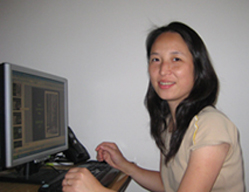 陶懿 TAO Yi, Ph.D.
陶懿 TAO Yi, Ph.D.
教授,博士生导师
课题组组长
电话:+86-592-2180852
E-mail:yitao@xmu.edu.cn
1991-1996, 北京大学学士学位植物分子及发育生物学
1999-2004,斯克里普斯研究所博士学位大分子及细胞结构与化学
1999-2004,索尔克生物研究所博士后
2007年至今,厦门大学生命科学学院,教授
1991-1996,Peking University, B.S., Plant Molecular and Developmental Biology, 1999-2004,The Scripps Research Institute, Ph.D., Macromolecular & Cellular Structure and Chemistry,
1999-2004, The Salk Institute, Postdoctoral Fellow
2007-present,Xiamen University,professor
研究领域(Research Area)
光不仅是植物进行光合作用的能量源泉,而且是调控植物生长发育的重要环境因子。喜阳植物在遮荫条件下会诱发避荫综合症,其主要症状是将能量重新分配,用于伸长生长,从而获得更多的阳光。尽管避荫反应对单个植株的适应与生存是有利的,但是由于避荫反应会削弱植物叶片和储藏器官的发育,因此对提高大面积种植的作物产量是不利的。此外,避荫综合症还会导致植物抗病性的降低,引进进一步的减产。我们实验室致力于植物对光和遮荫信号的应答机制的研究。利用模式植物拟南芥和遗传学、生物化学、分子生物学等方法研究植物调控光反应的分子机制,发掘新的调控基因。
As sessile organism, plant has evolved the ability to cope with various biotic and abiotic stresses. Light serves not only as energy resource for plant, but also as an important environmental signal. It directs plant development throughout its whole life span. When sun plants are under canopy shade, they often display a set of responses that are collectively referred as the Shade Avoidance Syndrome (SAS). The main output of the SAS is re-allocation of energy resources towards elongation growth at stems and petioles, which allows the plant to compete for more light. Even though the SAS is beneficial to the fitness of individual plant, it causes reduction in crop yield due to reduced deposition to leaves and storage organs in shade-avoiding crops. In addition, plants displaying the SAS also exhibit higher disease susceptibility. We are interested in the molecular mechanisms of the light and the shade avoidance signal transduction pathway and their connections to plant disease resistance. Using model plant, Arabidopsis thaliana, we are working on identifying new components of light and shade avoidance signaling pathways through a combination of genetics, biochemical and molecular biology approaches. Our long term goal is to design crops that can be planted at high density and to increase crop yield and the efficiency of land usage.
代表性论文 (Selected Publications)
1.Moreno JE, Tao Y, Chory J, Ballaré CL. Ecological modulation of plant defense via phytochrome control of jasmonate sensitivity. Proc Natl Acad Sci U S A. 2009 24;106(12):4935-40.
2.Savaldi-Goldstein S, Baiga TJ, Pojer F, Dabi T, Butterfield C, Parry G, Santner A, Dharmasiri N, Tao Y, Estelle M, Noel JP, Chory J. New auxin analogs with growth-promoting effects in intact plants reveal a chemical strategy to improve hormone delivery. Proc. Nat. Acad. Sci U S A. 2008 105(39), 15190-5.
3.Tao Y., Ferrer JL. Pojer F., Hong F. Ljung K., Long J.A., Li L., Moreno J.E., Bowman M.E., Ivans L.J., Lim J., Ballare C.L., Sandberg G., Noel J.P., Chory J. Rapid synthesis of auxin via a new tryptophan-dependent pathway is required for the shade avoidance response of plants. Cell , 2008 133:164-176
4.Chen M.*, Tao Y.*, Lim J., Shaw A., Chory J. (2005) Regulation of phytochrome B nuclear localization through light-dependent unmasking of nuclear-localization signals. Curr. Biol. 12; 15(7):637-42.
5.Yin Y., Vafeados D., Tao Y., Yoshida S., Asami T., Chory J. (2005) A new class of transcription factors mediates brassinosteroid-regulated gene expression in Arabidopsis. Cell 120(2):249-59.
6.Tao Y., Xie Z., Chen W., Glazebrook J., Chang H.S., Han B., Zhu T., Zou G., Katagiri F. (2003) Quantitative nature of Arabidopsis responses during compatible and incompatible interactions with the bacterial pathogen Pseudomonas syringae. The Plant Cell 15:317-330.
7.Wu Y., Wood MD., Tao Y., Katagiri F. (2003) Direct delivery of bacterial avirulence proteins into resistant Arabidopsis protoplasts leads to hypersensitive cell death. The Plant Journal 33(1):131-7.
8.Chen W., Provart N.J., Glazebrook J., Katagiri F., Chang H.S., Eulgem T., Mauch F., Luan S., Zou G., Whitham S.A., Budworth P.R., Tao Y., Xie Z., Chen X., Lam S., Kreps J.A., Harper J.F., Si-Ammour A., Mauch-Mani B., Heinlein M., Kobayashi K., Hohn T., Dangl J.L., Wang X., Zhu T. (2002) Expression profile matrix of Arabidopsis transcription factor genes suggests their putative functions in response to environmental stresses. The Plant Cell 14(3):559-74.
9.Tao Y.*, Yuan F.*, Leister R.T., Ausubel F.M., Katagiri F. (2000) Mutational analysis of the Arabidopsis nucleotide binding site-leucine-rich repeat resistance gene RPS2. The Plant Cell 12(12):2541-2554.